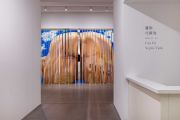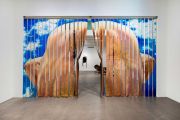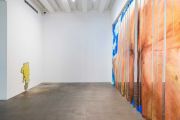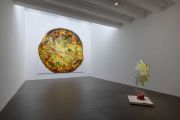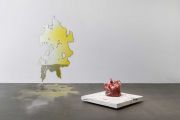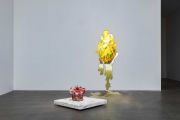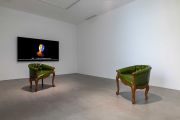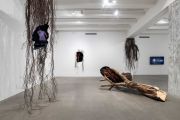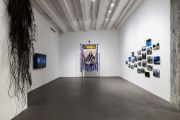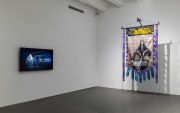Cao Yu
Septic Tank
May 21 - August 4, 2024
Galerie Urs Meile Beijing
Press Release - English
“Life is like sitting on an uneven bench. No matter how you sit, it’s uncomfortable. I need to constantly shift positions in search of a moment of comfort. This very process of adjustment is the process through which creativity is born.” —Cao Yu
Galerie Urs Meile Beijing is honored to announce Cao Yu’s (b. 1988, Liaoning Province) latest solo exhibition, Septic Tank. This exhibition is a sequel to the artist’s 2021 solo exhibition at Galerie Urs Meile Beijing, Passing Through the Human World. The works in this exhibition span the mediums of sculpture, photography, installation, painting, video, and performance. If Passing Through the Human World was the prelude, and featured a sweeping, detached, overarching view of the world, Septic Tank shifts to step directly into the world, pivoting toward microscopic observation and deep penetration from a “hidden” corner of society and life.
The title Septic Tank is a challenge and a provocation to the audience. Cao Yu boldly engages in a direct, even naked revelation of her insights into the world of human affairs. For her, the septic tank is not just a piercing metaphor for observations of the human world, but a synonym for “human purgatory” and the “corruption of society.” Moreover, it is also her “power to transform degenerate into divine, to transform all stress and unease into art.” This power enables her to turn indescribable pain into something
so sincere, so tangible, that all these invisible things are laid utterly bare.
The “Septic Tank” is one of mankind’s greatest inventions, yet it remains in the most “hidden” place, excluded from the shrine of the sublime for its filth, remaining a controversial, profane subject. But the septic tank’s concealed, overlooked state of existence will not vanish due to human aversion and silence. The works in the exhibition are Cao Yu’s deep thoughts and expressions of this state of existence.
Under the Sky (2022, oil on canvas, steel pipe, 360 × 600 cm) is a large-scale painting installation comprising multiple oil paintings the artist completed in the past few years, following the years of disaster experienced all across the world. Due to certain external factors, this multi-painting installation
which began as a single oil painting will be presented at the exhibition entrance. Passing under the hips, visitors will become the most central part of the artwork. Becoming a part of the exhibition through the act of viewing it.
The absurd photographic installation Phoenix (2021, 6 archival photographs, banyan tree: 125 × 310 × 160 cm), longxu root, configurations variable) leaves people laughing and wondering. The voluptuous trunk and roots of a Banyan Tree are awkwardly decorated with photographs of bare naked man
posing lasciviously with peacock feathers. In China, people often describe peacocks as “fake phoenixes.” The protagonists of the pictures seem to be completely devoid of hair or clothing, save for a single long feather. Even with just a single feather, they see themselves as “peacocks.” As the Chinese saying goes, when the peacock flies to the treetop, it becomes a phoenix. These “phoenixes” assembled around dried out tree branches seem to be waiting for their moment to soar into the sky.
In the installation work Piss-Take a Look at Yourself (2023, urine, series dimensions variable), Cao Yu continues her signature no-holds-barred style. There is a highly ironic Chinese proverb, take a piss and look at yourself, satirising those who think they are great. Cao Yu has turned urine into a mirror surface solid. Anyone who gazes within will have nowhere to escape, and each viewer is forced to look at this familiar yet strange self in a familiar yet strange way.
We will also present Cao Yu’s newest video work I Have (Part II) (2024, 6K single channel video, colour/sound, 5’55”), the sequel to I Have (2017). Aside from the heady boastfulness of the first part, in I Have (Part II), the artist’s emotions and experiences rise and fall with the tides of the times like symphonic waves, progressing in a rhythm sometimes fluid, sometimes halting, before shifting downward in the end, closing with a sense of “regret.”
The artist’s highly anticipated large-scale international project Dragon Head – Shanhe Declaration (2021–2024, embroidered satin war banners, iron tridents, leather rope, 346 × 165 cm, banners: 250 × 160 cm, documentary: 45, 24 archival prints, 300 × 420 cm) will also be presented in the show. The project has been in progress for three years, spanning six countries and nearly 20 cities and regions. The artwork title is derived from Cao Yu’s famous photographic work Dragon Head. Here, the artist takes on the persona of a strong, masculine woman unbound by gender. With her own body as the pedestal, she holds up “war banners” in the style of China’s Three Kingdoms period as she walks across great empty expanses of land
in various countries, recording her progress by GPS. Lands both populated and deserted serve as the sites for her artistic presentation and battles in life. This artwork is more than just one person’s singular manifesto and act of bravado to the world. It is also an individual’s way of squeezing a bit of empowerment from within the cracks in politics and society.
Cao Yu has said, “Making art is a form of self-rescue. It is my life-line.” Her ambitions, however, do not stop there. She strives to awaken more profound introspection and reflection, touching off broader and more forceful actions.
About the Artist
Cao Yu’s (b.1988, Liaoning. BFA & MA, Sculpture, Central Academy of Fine Arts, Beijing, China) works span a diverse range of media that include video, installation, performance, photography, sculpture and painting. She is famous for her incisive and bold artistic language, distinctive cross-disciplinary practice, witty and ironic expression. Cao has been recognized as one of the most influential emerging artists in Asia today, the leading figure of Chinese new generation female artists.
She has won numerous art awards both domestically and internationally: the winner of Best Young Artist · The 12th AAC Award (2018); Nomination Award Selected, Yishu · 8 Chinese Young Artist Award (2017); Nomination, the French Opline Prize (2019); Generation .T Asia’s Leaders of tomorrow
(2020); shortlisted, Chinese Contemporary Art Award (CCAA) (2018); China Art Power 100 (2018); Nomination, The Sovereign Asian Art Prize (2023), ect. Her works have been exhibited globally at important museums and institutions including Kunstuseum Wolfsburg, Wolfsburg , Germany; MAK Museum für Angewandte Kunst, Vienna, Austria; Palais-de-Tokyo, Paris, France; Lilehammer Art Museum, Norwegian; Museum der Moderne, Salzburg, Austria; Kunstforeningen Gamle Strand, Copenhagen, Denmark;
SongEun Art and Cultural Foundation, Seoul, Korea; Artspace, Sydney, Australia; Minsheng Art Museum, China; Ulsan Art museum, South Korea; Martina Tauber Fine Art, Munich, Germany; Diskurs, Berlin, Germany; Camera Club New York, USA; Guangdong Museum of Art ,Guangzhou, China; Wuhan Art Museum, Wuhan, China; MOCA YINCHUAN, YinChuan, China, etc. Her work are also in the collections of museums and institutions that include M+ Collection, Hong Kong; Erlenmeyer Stiftung, Basel, Switzerland; FB Art Collection Bolzano, Italy; The Cloud Collection, Nanjing; Sishang Art Museum, Beijing; Central Academy of Fine Arts Art Museum, Beijing, etc.
Her artistic exploration involves complex issues such as gender identity, survival status, major historical events, humanity, interpersonal relationships, etc. By using her own physical self, Cao Yu pushes boundaries and articulates a bold new voice for her own and succeeding generations. Her works also shed new light on relevant and timely women’s issues, making her works about gender and identity almost a phenomenon initiated by herself. In the process, the work of this free spirit and focused artist,
opens up new possibilities. Her artistic practice has made significant contributions to the status and development of contemporary art, especially among female artists in the Chinese art community, it is of great significance for understanding the development of women’s art in contemporary China and the context of globalization.
Downloads
Press Release (PDF English)
Press Release (PDF Chinese)
Opening:
Tuesday, May 21, 2024; 4.30pm – 6.30pm

